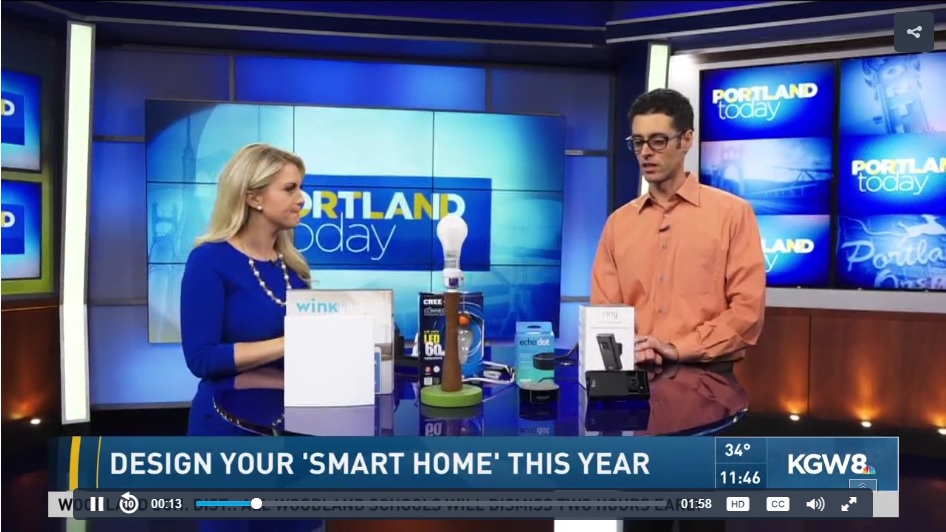Wink Hub 2 Review
Pros
Cons
Rating
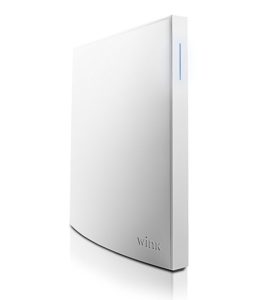
Introduction
If there’s any area of tech that’s poised for major growth. it’s the Smart Home market. Truth be told, it’s been that way for a few years, and yet the Smart Home is still growing in fits and starts. There are a couple of things that have kept Smart Home tech from achieving its full potential. For one, competing standards caused significant splintering of the market. Secondly, Smart Home products have typically relied heavily on smartphones for control, which we think just doesn’t play out that well in an actual home. The subject of this review, the Wink Hub 2, is a second attempt by Manhattan-based Wink at solving the first of these two problems, and we think it has the potential to become a dominant player in the Smart Home market.
First, a little history. Over the past few years, a number of companies have released Smart Home devices with their own proprietary hubs, some to disastrous effect. Support for the proprietary TCP Connected line of bulbs was withdrawn in mid-2016, making the products worthless (we were forced to throw out hundreds of dollars worth of TCP equipment). Other examples include the defunct Belkin Wemo bulbs, as well as the still-current Philips Hue bulbs and Lutron Caseta dimmers. It’s very hard for a company that sells specific devices to open up its hubs to competitors, so the task of marketing universal hubs fell on the shoulders of a few small startups. The companies hoped that third parties would release products worthy of paring with them. One of these was Wink, which launched the original Wink Hub in 2014. On its own, it did nothing at all, but paired up with third-party products like light bulbs, switches, thermostats, locks, cameras, or sensors, and in theory it could control practically everything in your home.
Wink’s main competitor was SmartThings, which had its own universal hub, and for a while, SmartThings, which had a head start, looked to be the winning design. Wink’s parent company Quirky filed for bankruptcy in 2015, just a year after Wink was founded, leaving Wink’s fate hanging in the balance. Meanwhile, SmartThings was gobbled up by Samsung, which probably had in mind integrating its IP into the Samsung home theater and appliance ecosystem.
Luckily for Wink, it had one factor weighing heavily in its favor: price. All along, Wink undercut SmartThings significantly, originally selling its hub for $50, whereas the SmartThings hub retailed for $100. No doubt, Wink was losing money selling its product at $50, and while it likely made up a bit of the difference via licensing fees charged to third parties that displayed the “Wink” logo, the business model was no doubt fraught with risk. Amazingly, Wink survived the bankruptcy of its parent company, and after this narrow escape, Wink raised the price of its original Hub to $70. This no doubt helped make ends meet, and with the release of the Hub 2 in September 2016, Wink raised prices again to $100, matching its competitor, this time with a clearly superior product.
Let’s dive into the workings of the Hub 2 to see if it makes a strong case not only for its $100 price tag, but also for becoming the center of your Smart Home. And in case you’d like to see a little live demo, check out the clip below of The Tech Buyer’s Guru discussing the Wink Hub 2 on KGW-8’s Portland Today show.
Description and Features
The Wink Hub 2 measures 7.25″ x 7.25″ x 1.25″, and with its graceful curves, it’s a bit more stylish than the original Wink Hub, which interestingly had the exact same height and width, but measured 1.75″ in thickness. This transformation is impressive given that the Hub 2 is packed full of tech, much of it missing from the original Hub. The list includes improvements to its networking hardware, specifically the addition of an Ethernet port for a direct wired connection to routers, as well as dual 802.11n WiFi radios. This allows users who can’t or don’t want to use a wired connection to link the Hub 2 to their routers using either the legacy 2.4GHz spectrum or the less congested and much faster 5GHz spectrum.
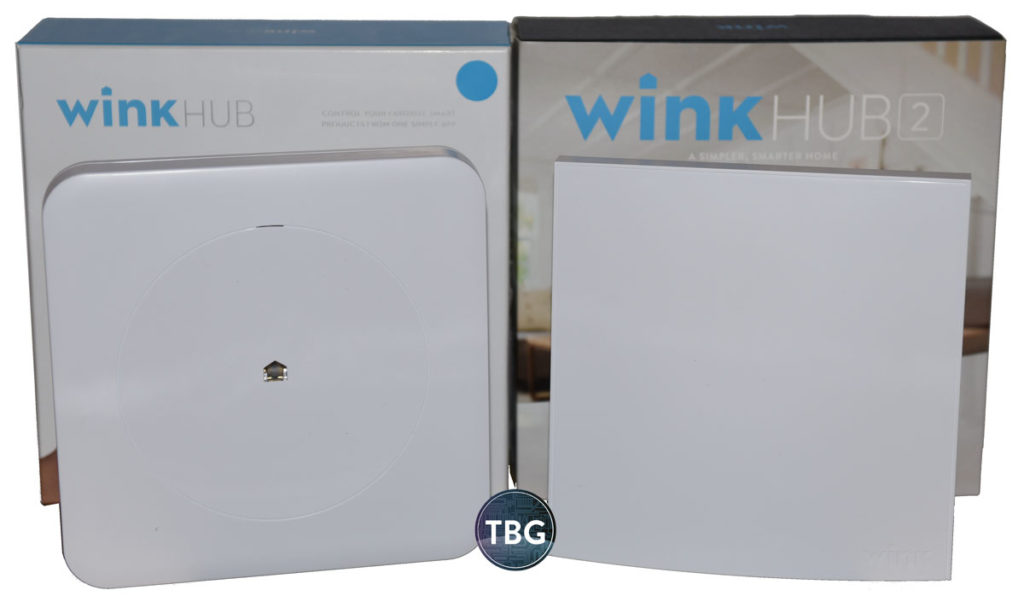
Note that WiFi is strictly used to connect to routers, as most Smart Home devices communicate with lower-powered, more efficient standards, because turning a device on and off ultimately doesn’t require a whole lot of bandwidth. Security cameras are the exception here, and the Hub 2 actually cannot directly access their video, relying on the camera manufacturers to stream it off servers instead. While the original Wink Hub was well equipped with regard to low-power wireless standards, including Z-Wave and ZigBee, the Hub 2 goes the next step and adds the new Bluetooth LE standard. Alas, we’re pretty sure Bluetooth LE will prove irrelevant, despite the best efforts of the the Bluetooth Special Interest Group, which licenses Bluetooth technologies, to play catch up here. ZigBee and Z-Wave are definitely the standards to beat at this point. But perhaps the Hub 2’s biggest upgrade comes in another area: good old fashioned memory. The Hub 2 sports eight times the onboard memory (512MB vs. 64MB) of its predecessor.
This last feature allows the Hub 2 to operate far more independently than the original Hub, which was forced to fall back on the “cloud” for much of its instruction storage and processing. The latency this created could make the act of turning on a lightbulb sometimes feel like watching grass grow. Similarly, “robots,” which in Wink parlance refers to using one device to trigger another, had to be processed by Wink’s servers. With the Hub 2, a whole lot more can be managed within the confines of the home network. Wink refers to this in marketing speak as “Enhanced Local Control.” We’d call it an essential upgrade for Smart Home power users.
All right, now that we know a bit more about the Hub 2’s features, let’s take a look at how they all work in the real world!
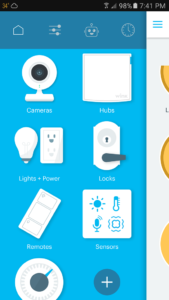
Performance
There are a few ways to judge the performance of the Wink Hub 2. First, we can look at ease of setup and device installation. Second, we can look at performance via the Wink app. And third, we can look at how the device works independent of the app, either via a schedule, triggers, or another control method, such as the Amazon Echo voice assistant. We’ll consider each of these in turn, starting with setup. To test the Wink Hub 2, we used the following third-party devices:
- one Amazon Echo
- two Amazon Echo Dots
- five Lutron Caseta dimmers
- four Lutron Pico remotes
- four GE Link BR30 bulbs
- five Cree Connected bulbs
- one Commercial Electric smart downlight
- two Leviton Decora Z-Wave dimmers
- one Leviton Decora Z-Wave switch
- one Leviton plug-in dimmer module
- one Leviton plug-in appliance module
- one Ring Stick Up Cam
- one Carrier Cor thermostat
- one Schlage Connect smart lock
Device installation was fairly straightforward. We already had a large number of devices working on the original Hub, and the Wink Hub 2 walked us through transferring our device over. The one sticking point was that our Lutron Caseta switches all needed to be manually reconnected one at a time, but at least the Wink App made this clear from the start. We also tried adding a few new products from scratch to the Wink Hub 2, and setup worked well, but we’re a bit surprised it isn’t even a bit faster. The Wink Hub 2 may be quicker than the original Hub, but new users may still be flummoxed by the process, thinking that their products are not connecting when in fact it just requires a bit of a wait. We were also a little surprised that the WiFi setup was more complicated than with the original Hub, and we’re pretty sure Wink has designed the Hub 2 to favor a hard-wired connection. We don’t blame the company, as it removes a significant source of technical problems. That being said, once we got up and running via hard-wired connection, it was overly complicated to switch to a wireless connection.
In terms of performing operations via the Wink App, controls were very fast, but this was true of the original Hub too, at least for lighting, which had gone “local” with a firmware upgrade in early 2016. What the Hub 2 offers is faster control of other devices, particularly locks, which were never locally controlled before. We can confirm that the Hub 2 was much faster locking and unlocking our Schlage Connect lock. Unfortunately, we found that the App still seemed laggy, displaying the wrong status for certain products, or only showing status changes long after the change took effect. For example you might tap the App to shut off a light, which would happen instantaneously, but the App would continue to show the light as on for 10 seconds or so.
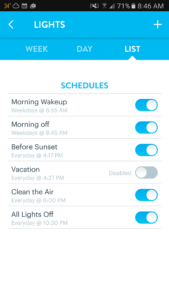
Another issue we have with the Wink App is that while it’s cheerful and cute, it’s not particularly well organized. Given how many types of devices the Wink Hub 2 can control, we’re simply shocked that Wink has continued to separate out schedules by device type. This just isn’t how people operate devices while they’re at home; they’re much more likely to do so by room. Want to schedule your living room lights to turn on, blinds to close, and thermostat to turn up the heat at sunset? That’s going to require three different schedules, thank you very much. We also think Wink should add a schedule option for locks. We totally understand that scheduling the unlocking of doors isn’t safe, but scheduling the locking of doors makes a lot of sense, and yet isn’t possible in the current App.
Luckily, all of these troubles fade away once you combine the Wink Hub 2 with an Amazon Echo. Simply put, this is the future of home automation. Where the Wink App may stumble in controlling devices, the Echo almost always gets it right, and does it faster too. As far as we’re concerned, users should be setting up schedules with the Wink App, and then never looking at it again, using Echoes to control devices on a daily basis. It’s amazing to think that when the original Hub was launched, there was no Echo, and when the Echo launched a few months later, it didn’t heavily advertise its compatibility with Wink. Simply put, these two products were made for each other! We’ll also give a shout out to our favorite lighting products, the Cree Connected bulb and the Lutron Caseta dimmers, which are simply best-in-class in terms of ease-of-use and performance.
We can’t quite say the same of all third-party devices, and indeed Wink is let down most by certain products that it’s forced to back via its website and tech support representatives. We’ve found issues with a number of our lighting products, specifically the GE Link bulb, which loses its association with the Wink app and requires reinstallation whenever the Hub is turned off or loses power, and the Commercial Electric Smart Downlight, which sometimes does the same thing, and is an absolute pain to get reconnected. We wouldn’t recommend either light at this point. We also feel that security cameras just aren’t all that well integrated into Wink, in part because they can’t directly communicate with the Hub (they use WiFi to send data, which Wink doesn’t use for devices). The Ring Stick Up Cam we sampled is best described as a work in progress in terms of functionality. While its fully-wireless design is very appealing, aggressive battery management is needed to keep it running, which limits what Wink can do with it. Basically, it’s only useful as a motion sensor in the Wink environment.
Conclusion
In drawing conclusions about the Wink Hub 2, it’s hard to escape the fact that the Hub 2 is only as good as the devices you pair with it. And that makes it a difficult product to rate, and likely a very difficult product to make money on (indeed, as of early 2016, Wink still wasn’t profitable, but perhaps the Hub 2 will help it turn a corner in that regard). But in surpassing both its predecessor and all of its competitors, the Hub 2 has become the Smart Home hub to beat. It’s sleek, easy to use, offers robust hardware, and is backed by the most dedicated team of tech support agents we’ve ever encountered. Seriously, they really want you to get the most out of this product! Alas, the Wink App, which for many consumers will be the main method of interaction with Smart Home devices, is in desperate need of a revamp. It’s utilized the same basic layout for years, but times have changed, and the App needs changing too. Luckily, that’s something Wink can continue to work on, meaning today’s buyers of the Hub 2 will be able to enjoy an even better experience down the line.
The Wink Hub 2 is available for $99 shipped from Amazon, as of our publication date, and not surprisingly is selling quite well.
For advice on the best gear to buy when setting up your own Smart Home, see our Smart Home Buyer’s Guide, our Smart Lighting Buyer’s Guide, and for an overview of what Smart Home tech can do for you, see our Complete Guide to the Smart Home.



